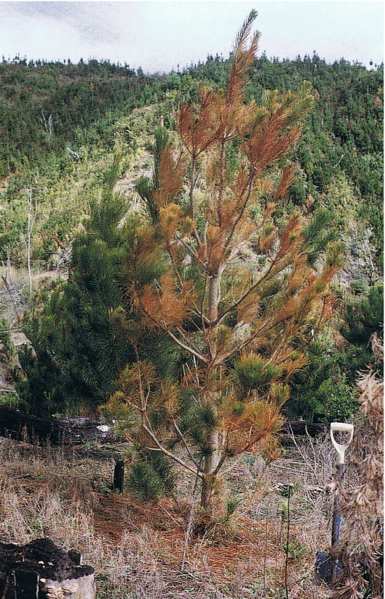PESTS AND DISEASES OF FORESTRY IN NEW ZEALAND
Junghuhnia root rot
Scion is the leading provider of forest-related knowledge in New Zealand
Formerly known as the Forest Research Institute, Scion has been a leader in research relating to forest health for over 50 years. The Rotorua-based Crown Research Institute continues to provide science that will protect all forests from damage caused by insect pests, pathogens and weeds. The information presented below arises from these research activities.
Root rot caused by Junghuhnia vincta.
From Scion publication Forest Research Bulletin 220, An Introduction to The Diseases of Forest and Amenity Trees in New Zealand, G.S.Ridley and M.A. Dick 2001.
(See also Junghuhnia Root Disease, Forest Pathology in New Zealand No. 18 )
Species: Junghuhnia vincta (synonyms: Poria vincta, Rigidoporus vinctus) (Basidiomycete)
Common name: Junghuhnia root rot
Country of origin: New Zealand
Host(s): Junghuhnia vincta is parasitic on various introduced conifers and hardwood trees, and is comparatively common as a wood-decay fungus in broadleaved/podocarp forests. It has been recorded from the following hosts: Acacia, Acmena, Beilschmiedia, Berberis, Betula, Corynocarpus, Cryptomeria, Cupressocyparis, Cupressus, Dysoxylum, Eucalyptus, Hoheria, Nothofagus, Paraserianthes, Phebalium, Pinus, Pittosporum, Plagianthus, Populus, Salix, and Thuja.
Symptoms: Progressive yellowing and browning of foliage, beginning with older needles, but progress may be uneven as some branches are affected before others (Fig. 79); resinosis on roots and root collar, and cankering may occur; small pads of white or pale pink fungal tissue on root surface below and just above soil level; occasionally fruit-bodies develop just above soil level (a pink fungal encrustation with pores).

Fig. 79: Mortality of Pinus radiata caused by Junghuhnia vincta
Disease development: Pines become infected through root contact with the fungus inhabiting the wood debris from the previous native forest. Basidiospores may also play a part in setting up new infection centres by colonising stumps or wood debris. Mortality among pines is scattered or in the form of small groups of two or three trees. Infection develops slowly within and between trees, taking several years to progress. Dead roots develop a soft white wood-decay that may be traversed by black zone lines. The disease is known only in young pines (less than 10 years old).
NZ distribution: Most records of the causal agent are from the northern half of the North Island. The disease is known principally from the Bay of Plenty and the Waikato. Where it causes tree deaths in orchard shelterbelt trees in the Bay of Plenty, it is known as white crown canker disease.
Economic impact: Not considered of economic importance.
Control: Not considered necessary because of its low incidence.
References: Dick 1987; Hood & Dick 1988;Taylor 1984.
This information is intended for general interest only. It is not intended to be a substitute for specific specialist advice on any matter and should not be relied on for that purpose. Scion will not be liable for any direct, indirect, incidental, special, consequential or exemplary damages, loss of profits, or any other intangible losses that result from using the information provided on this site.
(Scion is the trading name of the New Zealand Forest Research Institute Limited.)

 Farm Forestry New Zealand
Farm Forestry New Zealand

